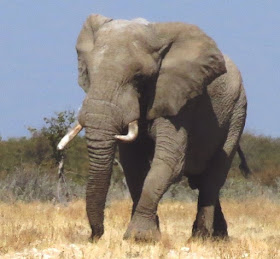 |
| Majestic elephants are common sights in Etosha National Park in Namibia. |
Namibia’s premier wildlife viewing destination is a
huge expanse of savannah in the northwest part of the country. Etosha NationalPark is one of the oldest and largest parks in Africa and hosts a plethora of
large mammals and spectacular birds. This is true despite the fact a huge
salt pan, remnant of a huge lake that existed two million years ago, covers a
fifth of its surface area, and this shimmering white expanse is extremely
inhospitable to living things.
Actually, it’s the Etosha Pan for which the region
is most famous and the park is named. Almost entirely devoid of vegetation,
most game gathers along the rim (especially to the south) of the pan which
makes viewing wildlife a bit easier. About 50 natural and manmade waterholes
attract a variety of species and allow for excellent viewing when staking your
spot nearby. When the rainy season begins in November, the animals seldom need
to visit the waterholes along the tourist routes, congregating instead in large
herds on the grassy plains.  |
| The arid Etosha salt pan is easily visible from the air. |
 |
| Small planes take us from one camp to another. |
 |
| Fantastic view from our cabin in Ongava Lodge and Reserve in Namibia |
Following our fifth and sixth flights on
puddle-jumper planes in Namibia, we eventually arrive at Ongava Lodge and Reserve, a
luxurious hilltop lodge set high on a ridge inside a private game reserve with
resident white and black rhino and a busy water hole. This private game reserve
adjoining Etosha is a conservation success story that developed when local
families turned unproductive cattle ranches into a prolific 74,000-acre haven
to rehabilitate and reintroduce wildlife.
 |
| Female lions drink while they wait for the male to eat his fill of their recent giraffe kill. |
 |
| Different species co-exist peacefully in the wild. |
Soon another truck comes by. Since the guide is an
employee of the Reserve (our guide is employed by the tour company Natural Habitat) he is
allowed to have a rifle which is required if anyone leaves the safari vehicle.
They had spotted white rhinos—the color refers to the mouth—so we join their
group as they exit the vehicles and walk towards a group of a dozen
rhinos coming across the plain in our direction.
 |
| White rhinos approach our group of travelers before meandering another way. |
Back in the vehicle, we spot more plains animals
like zebras, Oryx, springbok, impala, and many vibrantly-colored birds.
 |
| Cabins in wildlife camps are often basic but comfortable, although some are fairly luxurious. |
Multiple species of wildlife will drink at water
holes at the same time, but they are always on guard checking for predators.
Not surprisingly, impala, antelopes, and ostriches move out of the way as we
watch a large bull elephant approach a waterhole. While he isn’t a life threat,
his sheer size is intimidating to other animals. Watching the
elephant splash, blow bubbles, and suck water into his trunk, curl it upward,
and lift the trunk to squirt water into his cavernous mouth is fascinating. His movements are
slow and deliberate—necessary for such a large body.
 |
| A bull elephant splashes water on himself. |
 |
| A family of elephants leaves a water hole. |
Another highlight of our day in Etosha National Park
is watching two giraffes walk in smooth, graceful movements toward a water
hole. Giraffes are very cautious as they cross the plain and approach the water
hole, stopping often to sense if danger lurks. They drink one at a time because
when they bend down on their knees to drink giraffes can’t get up fast to run
if prey should strike. Because they are more vulnerable, they do not scare
other animals away from the water as the elephant did.
 |
| Giraffes are vulnerable to prey when bending down to drink. |
Photos by Larry and Beverly Burmeier

No comments:
Post a Comment